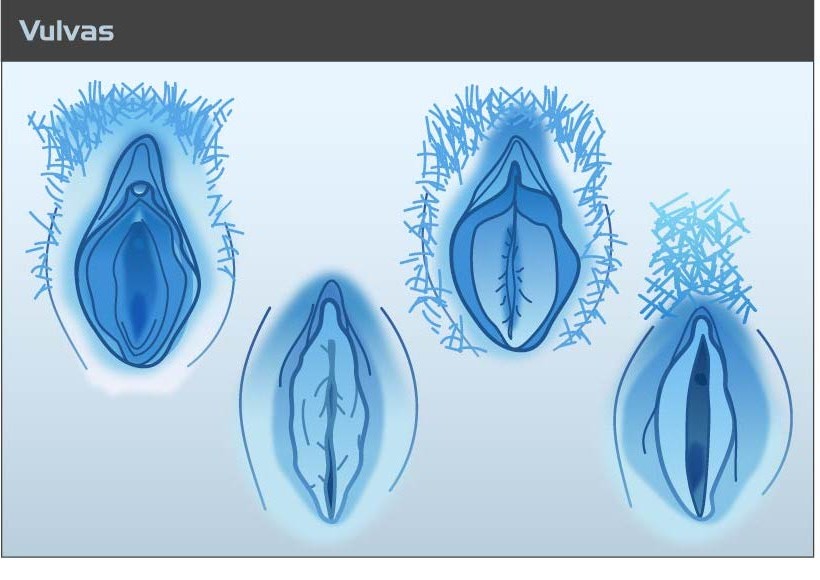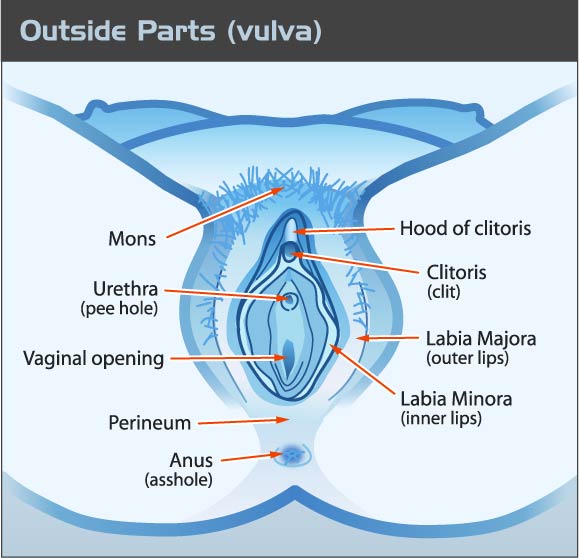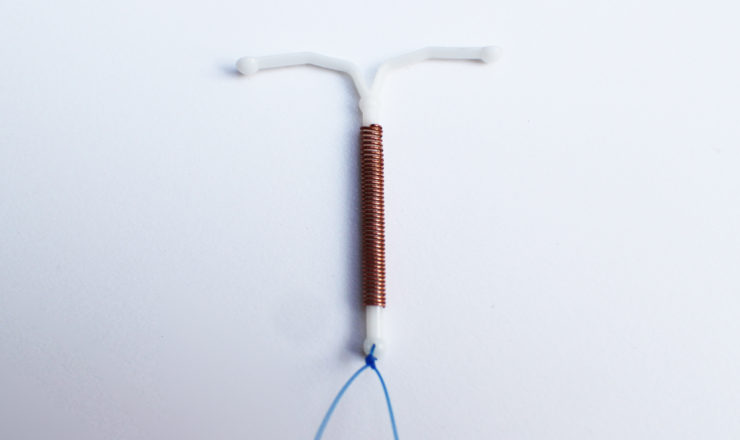Vulvas
Here are some tips on taking care of and enjoying your parts if you have a vulva.
Not everyone experiences or relates to their vulva in the same way or uses the words used on this website for their bodies. We support you using the language that feels best for you.
Know your parts
Vulva
- Your vulva consists of the whole genital area; labia majora, labia minora, clitoris (and clitoral hood), vagina*, and the opening to your urethra.
- Your vulva is often referred to as a “vagina”, but your vagina is actually the muscular canal leading from your outer vulva to your cervix and uterus.
Labia (Lips)
- The word labia literally means “lips” in Latin.
- There are two types of labia: labia majora (outer lips) and labia minora (inner lips).
- Your outer lips consist of fatty tissue and contain many blood vessels. When sexually aroused they can swell and become sexually sensitive.
- Your inner lips connect from your clitoral hood to your vaginal opening. They keep bacteria away from your vagina.
Clitoris (Clit)
- Your clit’s single purpose is pleasure and it is packed with thousands of nerves, veins and muscles.
- Your clit is located under your clitoral hood, which is where your inner lips meet at the top of your vulva.
- The clitoral head (glans) is what’s visible when you look under your clitoral hood. The clit actually extends 4-5 inches inside the body.
- During sexual arousal extra blood rushes into your clit and it may become erect and swollen. Your clit may also become sensitive to touch.
- The size, colour and shape of your clit can vary among individuals.
- Your clitoral head (glans) may have been removed or altered.
Vagina
- Your vagina is the canal that connects your vulva to your internal sex organs (cervix, uterus and fallopian tubes).
- The vaginal canal is 3-4 inches long when not aroused.
- Your vagina may be referred to as the birth canal, as this is where the baby passes through during vaginal childbirth.
- Your vagina is where penises/toys/fingers/tongues may enter during vaginal penetration.
- The walls of your vagina are often naturally lubricated similar to your mouth. This fluid is made mostly of water that your body produces.
- Vaginal walls can also self-lubricate when sexually aroused.
- For more information on Vaginas, please check out Inside Scoop: Vagina and Uterus [Link].
Hymen
- The hymen is a thin tissue that may stretch across the opening of the vagina. Everyone’s hymen is different.
- The hymen has at least one opening that allows fluid to pass out of the body.
- The hymen may be stretched from vigorous activity or injury (using tampons, being penetrated, riding a bicycle, etc). You may or may not experience bleeding or discomfort the first time your hymen is stretched.
Opening to your urethra/urethral opening
- Your urethra carries pee from your bladder. The urethral opening is where pee comes out.
- It is located below your clit and above your vaginal opening.
Cervix
- The cervix is the lower part of the uterus – the cervix is the point where the uterus connects with the top of the vagina.
- The cervix has an opening that allows sperm and fluids to pass through.
What does a vulva look like?

- Vulvas (lips, clitoris, vagina) come in all shapes, sizes and colours.
- It is normal for your lips to change or deepen in colour throughout your lifespan.
- Outer lips often have pubic hair and sometimes the hair covers the rest of the vulva.
- Inner lips may vary from each other in size, shape and length. Some inner lips are exposed and may be longer than your outer lips, while others may not be visible without spreading your outer lips.
- Sexual arousal may cause your vulva to increase in size and change colour.
- No matter how your vulva looks, you will be able to enjoy sex and be a good sexual partner. Sex is about how you interact with your partner(s), not the look of your body parts.
- One of the best ways to love your body is to be comfortable with it. If you are unhappy with the appearance of your vulva, it can help to think differently about your body instead of changing the way your body looks. Look for partner(s) who make you feel good about your body, not worse.
What comes out of your vulva and vagina?
Squirting/Ejaculation (Cum)
- Your Skene’s glands make ejaculate fluid, and are located in your vulva near the opening of your urethra.
- When you’re about to ejaculate, you may feel pressure near your bladder, similar to when you have to pee. Ejaculate fluid is often mistaken for pee, but it chemically different.
- This fluid is watery and not slippery. It can come out in small trickles or it may “squirt” out.
- Ejaculation/squirting may happen when you have an orgasm, but not always. Not everyone ejaculates.
Sexual arousal fluid
- When sexually aroused, your body may naturally produce lubricating fluid that is cloudy or clear and feels wet.
- This fluid acts as a natural lubricant that may make sex more pleasurable. It also helps prevent condoms from breaking.
Cervical mucous (Discharge)
- Your cervix makes mucous that varies in thickness, texture and colour throughout your fertility cycle. You might see this on your underwear.
- Cervical mucous is often cloudy at the start of your cycle and becomes clear and stretchy as you approach ovulation. At ovulation, cervical mucous helps sperm survive as they travel up the uterus.
- This mucous lubricates the vaginal walls and protects the cervical opening.
Blood
- Blood comes out of the vagina every month as part of the fertility cycle.This is called a period. The amount and frequency is different for everyone.
- Spotting (often brown or light pink) is a small amount of blood that comes out at times other than during a period.
- Some people with vulvas don’t have periods.
Urine (Pee)
- Urine comes from your bladder, travels through your urethra and exits out of your urethral opening.
Taking care of your vulva
Vulva health
- Your vagina is self-cleaning and does not need any special soaps, cleaners or douches. These may disturb the natural, normal balance of bacteria found in your vagina, and can cause vaginitis (inflammation of the vagina).
- Avoid soaps and menstrual products that are fragranced and have chemicals.
- Wiping from front to back is a good way to avoid dragging bacteria from your butt to your vulva.
- Your vulva has a natural scent that comes from sweat and bodily fluids. If you notice a scent that is unusual for you, talk to your clinician.
- You do not need to clean your vulva or vagina after sex.
- Peeing after sex can help lower your risk of a urinary tract infection (UTI).
- What’s normal is different for everyone. If something is unusual for you, it’s a good idea to check in with a healthcare provider.
Grooming
Some people like to groom their pubic hair, and others prefer to let it grow. This is a personal decision and has no impact on sexual health. If you decide to groom, here are some things to keep in mind:
- There are different ways to remove hair, including: scissors, clippers, shaving, waxing, depilatories (chemicals that break down the hair), electrolysis and laser hair removal.
- For methods that do allow hair to grow back, it will not grow back longer or thicker than before.
- Many people go to professionals for hair removal. If you are visiting a professional, ask about their equipment-cleaning practices.
Pap Tests (Pap Smear)
- A pap test is a medical test used to find changes to cells in your cervix, which may develop into cervical cancer or other abnormalities.
- Ontario guidelines recommend that anyone who has a cervix should have a Pap test every three years starting at age 21.
- For more info, check out our page on Paps [Link].
Pleasure Zones
- Some people find it very pleasurable to have their clit touched with fingers, mouths or vibrating toys. Some clits need more or less pressure, some like being touched only on a part of the clit and some don’t like being touched at all. Many people are able to reach orgasm through clitoral stimulation.
- The “g-spot” refers to a group of very sensitive tissues inside the vagina. Some people are able to find their g-spot by inserting two fingers or a toy a few inches deep and pressing on the wall of the vagina towards your belly button. Touching the g-spot can sometimes make you feel like you need to pee, even if you don’t.
- Some people find vaginal penetration to be very pleasurable, but many people do not reach orgasm from penetration alone.
- The perineum, the area of skin between your anus and your vagina, is filled with lots of nerve endings. Some people find having their perineum touched very stimulating.
- Lots of people like to stimulate or be stimulated in other areas. Some of these “hot spots” can include ears, neck, nipples, armpits, thighs, butt, and feet to name a few – have fun and explore!
Arousal
- When you are aroused, blood flows to your vulva, causing your clit and lips to swell and become more sensitive to touch.
- The vagina becomes naturally lubricated. Factors like medication, genital surgery (vaginoplasty), hormonal fluctuations during your menstrual cycle and/or stress may affect how much the vagina lubricates.
- The physiological response of arousal may happen whether stimulated, and the response is involuntary. Feeling aroused does not mean that you should or want to engage in sexual activity. It is important to ask for and give consent (permission) verbally.
- Arousal can change over time and depending on what’s going on for you that day or where you are in your fertility cycle. For example, some people are really aroused and enjoy having sex during their period.
Orgasm
- Orgasm involves several involuntary contractions of the muscles in your vagina, perineum, and anus (butthole).
- Many people think that arousal involves a steady climb to the peak of arousal (orgasm) and then levels off. However, arousal is fluid, and levels of arousal can go back and forth and up and down. This is completely normal.
- Some people orgasm multiple times in a short time. Some orgasms last longer, and some may be more intense than others.
- Everyone has their own pace of reaching orgasm; it could take minutes or hours to reach orgasm.
- Orgasms may help relieve cramping during your period.
- Some folks may have never experienced the type of stimulation that works for their anatomy, and may have never had an orgasm. This doesn’t mean that they never will have one.
- You can have fun without having an orgasm! Not all sexual sexual activity has to end with an orgasm (your partner’s or your own).
Self-pleasure/masturbation
- Masturbation is stimulating your genitals or other parts of your body in a way that makes you feel good sexually. You can masturbate alone or with someone else.
- People may use their hand(s), objects or sex toys to pleasure themselves, while others use their imagination, porn or erotica.
- Many people masturbate, including people of all genders, abilities, sexualities, ethnicities, cultures, religions, and ages, as well as people who are single or in relationships.
- Masturbation is healthy and normal. It’s a great way to learn about your body and find out what feels good for you. It can also relieve stress, and there is no risk of sexually transmitted infections (STIs) or pregnancy.
- Masturbating cannot hurt you or physically change your body. You cannot get sick, go blind or grow extra hair from masturbating.
- You can masturbate as much as you like as long as you are still enjoying other activities in your life too. Some people masturbate several times a day, some a few times a week, and others every once in a while.
- Everyone is different and it’s important to find out what feels right for you.
- Choosing not to masturbate is okay too.
- For more info, check out our page on Masturbation [Link].
For a downloadable resource on this topic, please visit Planned Parenthood Toronto Factsheet Database.
If you have questions about this topic, feel free to contact one of our peer educators. [Link]
*We know that these aren’t the words everyone uses for their bodies (eg. trans folks), and support you using the language that feels best for you.
Last Edited: October 2020







